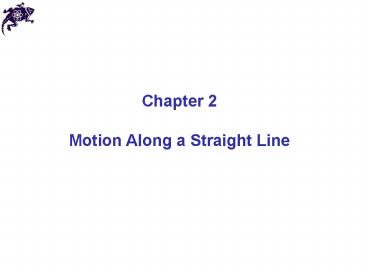Motion Along a Straight Line PowerPoint PPT Presentation
1 / 37
Title: Motion Along a Straight Line
1
Chapter 2 Motion Along a Straight Line
2
- Linear motion
- In this chapter we will consider moving objects
- Along a straight line
- With every portion of an object moving in the
same direction and at the same rate
(particle-like motion)
3
- Types of physical quantities
- In physics, quantities can be divided into such
general categories as scalars, vectors, matrices,
etc. - Scalars physical quantities that can be
described by their value (magnitude) only - Vectors physical quantities that can be
described by their value and direction
4
- Distance, position, and displacement
- Distance (scalar) a total length of the path
traveled regardless of direction (SI unit m) - In each instance we choose an origin a
reference point, convenient for further
calculations - Position of an object (vector) is described by
the shortest distance from the origin and
direction relative to the origin - Displacement (vector) a change from position
xi to position xf
5
- Velocity and speed
- Average speed (scalar) - a ratio of distance
traveled (over a time interval) to that time
interval (SI unit m/s) - Average velocity (vector) - a ratio of
displacement (over a time interval) to that time
interval - Instantaneous velocity (vector) velocity at a
given instant - Instantaneous speed (scalar) a magnitude of an
instantaneous velocity
6
Velocity and speed
7
Velocity and speed
8
- Instantaneous velocity
- The instantaneous velocity is the slope of the
line tangent to the x vs. t curve - This would be the green line
- The light blue lines show that as ?t gets
smaller, they approach the green line
9
- Acceleration
- Average acceleration (vector) - a ratio of
change of velocity (over a time interval) to that
time interval (SI unit (m/s)/s m/s2) - Instantaneous acceleration (vector) a rate of
change of velocity at a given instant
10
- Acceleration
- The slope (green line) of the velocity-time
graph is the acceleration - The blue line is the average acceleration
11
Chapter 2 Problem 15
An object moves along the x axis according to the
equation x(t) (3.00 t2 - 2.00 t 3.00) m,
where t is in seconds. Determine (a) the average
speed between t 2.00 s and t 3.00 s, (b) the
instantaneous speed at t 2.00 s and at t 3.00
s, (c) the average acceleration between t 2.00
s and t 3.00 s, and (d) the instantaneous
acceleration at t 2.00 s and t 3.00 s.
12
- Case of constant acceleration
- Average and instantaneous accelerations are the
same - Conventionally
- Then
13
- Case of constant acceleration
- Average and instantaneous accelerations are the
same - Conventionally
- Then
14
Case of constant acceleration
15
Case of constant acceleration
16
Case of constant acceleration To help you solve
problems
17
Chapter 2 Problem 28
A particle moves along the x axis. Its position
is given by the equation x 2 3t - 4t2, with x
in meters and t in seconds. Determine (a) its
position when it changes direction and (b) its
velocity when it returns to the position it had
at t 0.
18
- Case of free-fall acceleration
- At sea level of Earths mid-latitudes all
objects fall (in vacuum) with constant (downward)
acceleration of - a - g - 9.8 m/s2 - 32 ft/s2
- Conventionally, free fall is along a vertical
(upward) y-axis
19
Chapter 2 Problem 38
A ball is thrown directly downward, with an
initial speed of 8.00 m/s, from a height of 30.0
m. After what time interval does the ball strike
the ground?
20
Alternative derivation Using definitions and
initial conditions we obtain
21
Graphical representation
22
Graphical representation
23
Graphical representation
24
Graphical representation
25
Graphical representation
26
Graphical representation
27
Graphical representation
28
Graphical representation
29
Graphical representation
30
Graphical integration
31
Graphical integration
32
Answers to the even-numbered problems Chapter
2 Problem 4 (a) 50.0 m/s (b) 41.0 m/s
33
- Answers to the even-numbered problems
- Chapter 2
- Problem 6
- 27.0 m
- 27.0 m (18.0 m/s)?t (3.00 m/s2)(?t)2
- 18.0 m/s
34
Answers to the even-numbered problems Chapter
2 Problem 12 (b) 1.60 m/s2 0.800 m/s2
35
- Answers to the even-numbered problems
- Chapter 2
- Problem 20
- 6.61 m/s
- -0.448 m/s2
36
Answers to the even-numbered problems Chapter
2 Problem 38 1.79 s
37
Answers to the even-numbered problems Chapter
2 Problem 48 (b) 3.00 10-3 s (c) 450 m/s
(d) 0.900 m

